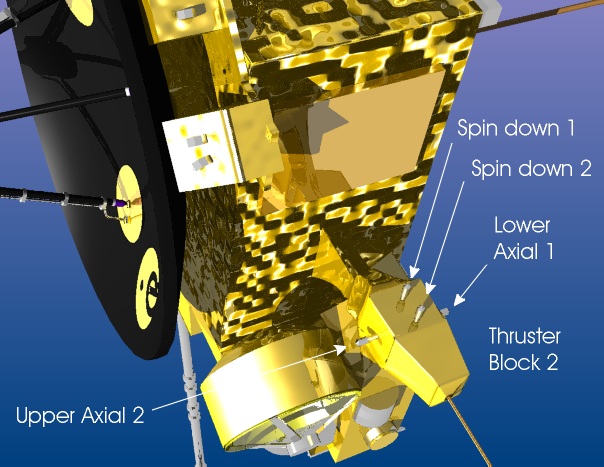Thruster Block 2 - Ulysses
You clicked on Thruster Block 2
Thruster block 2 is situated on the spacecraft -X wing. This structure holds four thrusters at the correct orientation, and at sufficient distance from the main body of the spacecraft to avoid plume impingement. It supports the associated fuel pipelines running from the inner platform. The thruster block thermal blankets provide thermal protection to the fuel pipes and Flow Control Valves in the assembly. The -X wing heater is also mounted on this thruster block.
The thruster block assembly also holds a wire boom drives - in the illustration, this is hidden by thermal blankets, but you can see the root of the 35 metre wire boom protruding along the X-axis.
The four thrusters on thruster block 2 are:
- Spin-down 1 (SD1). This thruster is part of Branch 1 of the Reaction Control Subsystem. It is used for (1) Making the spacecraft spin slower. (2) When fired in conjuction with Spin-up 1 on the opposite side of the spacecraft, for a radial delta-V manoeuvre. (3) When fired in conjuction with Spin-up 1 on the opposite side of the spacecraft, for a fuel dumping operation.
- Spin-down 2 (SD2). This thruster is part of Branch 2 of the Reaction Control Subsystem. This thruster has exactly the same functions as Spin-down 1, providing redundancy.
- Upper Axial 2 (UA2). This thruster is part of Branch 2 of the Reaction Control Subsystem. It can be used for (1) Routine Earth-pointing manoeuvres. (2) When fired in conjuction with Upper Axial 1 on the opposite side of the spacecraft, for a axial delta-V manoeuvre. (3) In special circumstances, when used alone, for a backup axial delta-V manoeuvre.
- Lower Axial 1 (LA1). LA1 is the most frequently used thruster on the spacecraft. It is currently used for all routine Earth-pointing manoeuvres. LA1 will be used for all routine manoeuvres for the foreseeable future, and is still in perfect operating condition. This thruster has a similar role to UA2 but is part of the prime RCS branch (Branch 1), and provides thrust in the opposite direction. It can be used for (1) Routine Earth-pointing manoeuvres. (2) When fired in conjuction with Lower Axial 2 on the opposite side of the spacecraft, for a axial delta-V manoeuvre. (3) In special circumstances, when used alone, for a backup axial delta-V manoeuvre.








































 Sign in
Sign in
 Science & Technology
Science & Technology
